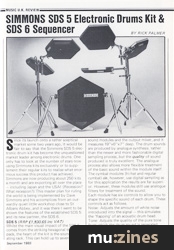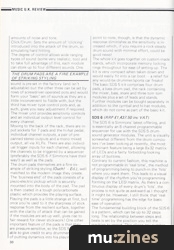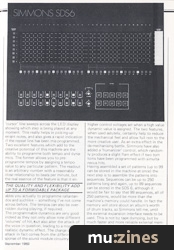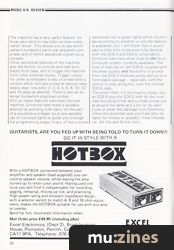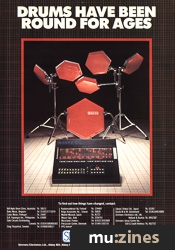Magazine Archive
Home -> Magazines -> Issues -> Articles in this issue -> View
Simmons SDS 5 Electronic Drums Kit & SDS 6 Sequencer | |
Article from Music UK, September 1983 | |
Simmons Electronic Drums + Sequencer, Rick Palmer gets switched on

Since its launch onto a rather sceptical market some two years ago, it would be fair to say that the Simmons SDS 5 electronic drum kit has become the unquestioned market leader among electronic drums. One only has to look at the number of stars now using Simmons kits exclusively or to supplement their regular kits to realise what enormous success this product has achieved. Simmons are now producing about 250 kits a month and are exporting all over the place — including Japan and the USA! (Recession? What recession?) This master plan for ruling the world is being implemented by Dave Simmons and his accomplices from an outwardly quiet little workshop close to St Albans Abbey, and it was there I went to be shown the features of the established SDS 5 and its new partner, the SDS 6.
SDS 5
(RRP £1,530.65 inc VAT)
Whilst the main visual impact of the SDS 5 comes from the striking hexagonal trigger pads, the heart of the kit is the sound generating rack. This can hold up to seven drum sound modules and the output mixer, and it measures 19"x6"x7" deep. The drum sounds are produced by analogue synthesis, rather than the newer and more fashionable digital sampling process, but the quality of sound produced is truly excellent. The analogue process also allows more flexible treatment of the basic sound within the module itself. The cymbal modules (hi-hat and regular cymbal) do, however, use digital sampling as for this application the results are far superior. However, these modules still use analogue filters for treatment of the sound.
Each module has six controls to allow you to shape the specific sound of each drum. These controls act as follows.
Noise: Adjusts the amount of white noise introduced into the signal — this simulates the 'flapping' of an acoustic drum head.
Tone: Adjusts the quality of the pure tone from which the drum sound is generated.
Bend: Alters the pitch of the drum tone.
Decay: Sets the amount of ring to the drum.
Noise/Tone: Balance control between the amounts of noise and tone.
Click/Drum: Sets the amount of 'clicking' introduced into the attack of the drum, so simulating hard hitting.
The degree of control allows wide ranging types of sound (some very realistic, too) and to take full advantage of this, each module can store up to four different sounds. One sound is pre-set in the factory (and isn't adjustable) but the other three can be set by rows of screwdriver-operated pots and would form your 'basic' set of sounds as they are a little inconvenient to fiddle with, but the third has mixer type control pots and, as such, gives you easy adjustment if required. The mixer unit provides sensitivity controls and an individual output level control for every channel.
"THE DRUM PADS ARE A FINE EXAMPLE OF STRIKING STYLING"
Moving to the back of the rack, there are input sockets for 7 pads and the hi-hat pedal, individual channel outputs, a pair of pre-panned stereo outputs and a mono mixed output, all via XLRs. There are also individual trigger inputs for each channel, allowing the channels to be triggered by a sequencer (preferably the SDS 6 if Simmons have their way!) as well as the pads.
The drum pads themselves are a fine example of striking styling (Ouch! - Ed.), well matched to the modern image they create. The 'business end' of the pads consists of a piezo-electric pickup which is securely mounted into the body of the pad. The pad is then coated in a tough polycarbonate plastic which provides the playing surface. Playing the pads is a little strange at first, but once you're used to it the sharpness of stick response from the resilient surface, together with the clarity of attack that can be gained if the modules are set-up well, gives rise to fair reward for clever stickwork! One other important feature of the pads is that they are pressure-sensitive, so the SDS 5 will be able to give credit to any drummer capable of putting dynamics into his playing. One point to note, though, is that the dynamic response diminishes as the sensitivity is increased which, if you require a rock-steady drum sound with minimal effort, could be good news!
The whole kit goes together on custom-made stands, which incorporate memory locking rings throughout for ease of setting-up. The kit is very compact when taken down and would easily fit into a car boot — a relief for any would-be drummer/sports car freaks! The basic SDS 5 kit comprises four drum pads, a bass drum pad, the rack containing the mixer, bass, snare and three tom tom modules plus a set of leads and stands.
Further modules can be bought separately in addition to the cymbal and hi-hat modules, which do not come as part of the basic kit.

SDS 6
(RRP £1,437.50 inc VAT)
The SDS 6 is Simmons' latest offering, and is essentially an 8 channel programmable sequencer for use with the SDS 5 drumsound generator modules. The unit is visually somewhat different from the drum computers I've been looking at recently, the most dominant feature being a large 8x32 matrix of LEDs and a fairly forbidding-looking array of buttons.
Contrary to current fashion, this machine is not programmable in 'real time', the method of programming being to punch-in the 'hits' where you want them. This leads to a visual display of the rhythm you're programming forming on the LED matrix. As there's a continuous display of every drum's 'hits', the process is not quite as awkward as I thought it might be. However, I still think that 'real time' programming has the edge for basic ease of operation.
The fundamental building block of the SDS 6 is a pattern, which can be up to 32 steps long. The relationship between steps and beats is set by the position you tell the machine to repeat. This allows any number of time signatures to be programmed into the machine.
As the SDS 6 plays back a pattern to you, a 'cursor' line sweeps across the LED display showing which step is being played at any moment. This really helps in picking-up errant notes, and also gives a rapid indication if the repeat line has been mis-programmed. Two excellent features which add to the creative potential of this machine are the ability to programme both tempo and dynamics. The former allows you to pre-programme tempos by assigning a tempo value to any particular pattern. The readout is an arbitrary number with a reasonably close relationship to beats per minute, but the real essence of the feature is that it enables you actually to programme rallantandos and suchlike — something I've not come across before. The tempos can also be overridden during playing, if required.
The programmable dynamics are very good indeed as they not only allow nine different 'volumes' of hit, but also alter the attack of the voice in question, leading to a most realistic dynamic effect. The change of attack in fact comes from the differing response of the sound module circuitry to higher control voltages set when a high value dynamic value is assigned. The two features, when used astutely, certainly help to reduce the mechanical feel and allow full rein to the more creative user. As an extra effect in the de-mechanising battle, Simmons have also added a 'humanizer' control, which randomly produces a slight flam effect if two tom toms have been programmed with simultaneous hits.
"THE QUALITY AND FLEXIBILITY ADD UP TO A FORMIDABLE PACKAGE"
Having assembled a set of patterns (up to 99 can be stored in the machine at once) the next step is to assemble the patterns into sequences. Sequences can be up to 250 patterns long and again, up to 99 sequences can be stored in the SDS 6, although it would be fair to say that 99 sequences, all of 250 patterns, would be more than the machine's memory could handle. In fact the memory will store about an album's worth of drum tracks, so Simmons tell me, until the external expansion interface needs to be used. This is not by tape dumping, but by much faster and more reliable external memory packs, which the Simmons can access in 0.4 seconds! Songs are assembled as a series of sequences, quite the standard arrangement, and very logical (Mr Spock).
The machine has a very useful feature for those who tend to lose their written notes, called 'show'. This allows you to see which pattern numbers a particular sequence comprises, and of which sequences a given song consists.
Other peripheral features of the machine give the facility to provide and read sync tracks from tape, and to trigger the machine from other external clocks. Trigger output for other synthesisers is also provided with a control which will give pulses at various rates (every step; one every 2, 3, 4, 5, 6, 8, 10, 12 and 16 steps as desired). There is also an external footswitch stop/start socket.
With so many features crammed into one machine, Simmons have made a laudable attempt at avoiding total panic on the part of a would-be purchaser by a very sensible use of coloured lights to guide you through the programming stages (many of the buttons have small red or green lights which illuminate according to whether or not the feature is available), but I still think that it would take a little time to become fully familiar with the SDS 5 and SDS 6 combination. Simmons have here what must be the drum computer system currently available. The host of features on the SDS 6, coupled with the sheer quality and flexibility of sounds from the SDS 5 modules surely add up to a formidable package — especially with the option to play along too, with the normal SDS 5 pads.
The price? Well, it's not exactly cheap, but an SDS 6 plus the SDS 5 with all the modules including hi-hat and cymbal comes out at around the same as a Linn on its own! Look at what this package from Simmons offers the drummer and you'll see why its value for money is, actually, most impressive. All this and British too!
Also featuring gear in this article
Simmons SDS6
(ES Jan 84)
Simmons SDS6 Sequencer
(EMM Feb 83)
Browse category: Drums (Electronic) > Simmons
Publisher: Music UK - Folly Publications
The current copyright owner/s of this content may differ from the originally published copyright notice.
More details on copyright ownership...
Review by Rick Palmer
Help Support The Things You Love
mu:zines is the result of thousands of hours of effort, and will require many thousands more going forward to reach our goals of getting all this content online.
If you value this resource, you can support this project - it really helps!
Donations for September 2025
Issues donated this month: 0
New issues that have been donated or scanned for us this month.
Funds donated this month: £0.00
All donations and support are gratefully appreciated - thank you.
Magazines Needed - Can You Help?
Do you have any of these magazine issues?
If so, and you can donate, lend or scan them to help complete our archive, please get in touch via the Contribute page - thanks!
